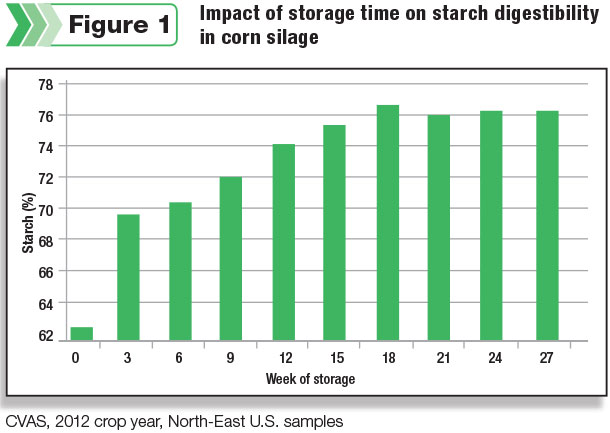When you opened your 2015 silage piles for the first time, were you filled with anticipation and confidence the new crop silage would meet your highest expectations for quality feed?
Many factors influence the quality of new-crop silage. Hybrid type, harvest practices, storage conditions and environment all contribute to a potentially wide range in silage quality. As you transition the 2015 silage crop into your rations, take management steps to maximize its potential. Then use lessons from the 2015 crop year to improve your silage quality next season.
Test before feeding
The first step is to understand the feed quality. Before feeding new-crop corn silage, submit a sample to your lab to determine moisture, starch, neutral detergent fiber (NDF), seven-hour starch digestibility, wet chemistry neutral detergent fiber digestibility (NDFd) and fermentation analysis.
These tests will help your nutritionist plan the ration transition by determining how filling the fiber will be and how much energy the cows can obtain from the silage. Continue to check NDFd and starch digestibility monthly as your silage continues to improve through fermentation.
As you feed your new silage, remember that NDFd is one of the most important measures of silage quality and has a strong link to cow performance. According to research at Michigan State University, every percentage-point increase in the diet NDFd increases milk production by 0.55 pounds of 4 percent fat-corrected milk.
Dairy producers and field nutritionists across south-central Pennsylvania are seeing a wide range of digestibility measurements in the 2015 corn silage crop. Dual-purpose hybrids grown in 2015 test from 47 percent to 53 percent 30-hour in vitro. Test results from 2015 BMR hybrids with the bm3 gene show a range of 65 percent to 72 percent 30-hour NDFd. This 12-percentage-point advantage in NDFd could result in an additional 5 pounds of milk per cow per day.
Fiber digestibility benefits seen in the bulk tank
Cow lactation performance demonstrates the benefits of feeding a corn silage with higher NDFd. I spoke with a dairy producer in Huntington County, Pennsylvania, who saw a 3-pound increase in milk per cow per day after feeding new-crop corn silage that was higher in NDFd. Improved feed management practices led to a 4 percent increase in NDFd.
Another Pennsylvania dairy producer cited a 4-pound milk increase per cow per day when transitioning cows from a fully fermented, dual-purpose silage to new-crop bm3 BMR silage. These results could be traced back to fiber digestibility since starch availability was limited by the length of time since ensiling.
Conversely, lower fiber digestibility has led to problems across the mid-Atlantic region. A field nutritionist from Lancaster County, Pennsylvania, reported cows struggling to hold milk when fed dual-purpose hybrid corn silage that had only 50 to 52 percent NDFd and 30 to 34 percent starch.
When production drops for cows eating a ration with new corn silage, sometimes the problem is related to fiber digestibility. If the NDFd of your corn silage is low, consider sourcing better-quality forages or substitute other sources of digestible fiber such as corn gluten feed, soyhulls or beet pulp to regain cow performance.
What about starch digestibility?
Some nutritionists argue that corn silage quality is not only about fiber digestibility but also about starch content. Starch is a major carbohydrate source and dense energy supply. However, total starch is not an indicator of starch digestibility or energy availability to the cow.

Hard, vitreous kernels often pass in manure because they are more difficult for rumen microbes to digest. Softer, textured kernels are easier for rumen microbes to break down. However, data from Cumberland Valley Analytical Services shows that starch digestibility improves over time when fermented in stable storage.
Harvest practices affect silage quality
As you feed your new-crop silage, be aware of how harvesting practices may have affected the final quality of your silage. Use clues from the new crop to help you plan harvest management improvements to improve silage quality next year.
Remember, these harvest management practices can have a significant impact on silage quality:
- Monitor crop maturity to find the optimum harvest time for the hybrids planted.
- Aim for the right combination of starch and fiber digestibility to support profitable milk production.
- Carefully plan and execute chop length and kernel processing.
- Stagger hybrid maturities to allow for proper moisture content at harvest.
- Ensure the farm crew packs the bunker tight enough to promote good fermentation.
Mid-Atlantic dairy producers saw the importance of these practices in 2015. Many faced some silage quality issues due to the early onset of harvest and rapid drydown. Harvesting when whole-plant moisture is too dry made packing and fermentation more challenging, leading to lower fiber digestibility and harder, more mature kernels.
Another issue with harvesting silage too dry is a slower, prolonged aerobic fermentation phase causing higher nutrient loss. Air exposure during feedout may cause a secondary fermentation, bringing additional challenges. Keep these factors in mind as you plan for the 2016 crop.
Silage quality impacts farm profitability
As the new crop is fed, continue to monitor milk production and test forages at intervals to assess feeding quality. Your need for purchased feeds may change over time. If the silage is highly digestible, we recommend feeding higher-forage diets to help reduce purchased feed costs. Remember: Starch digestibility will improve over time with fermentation during storage.
Consider all factors when selecting silage corn hybrids for next season, but don’t overlook the important role fiber digestibility plays in milk production. Consider using a tool like Michigan State University’s CornPicker for silage to help you measure how a silage hybrid choice could change your bottom line.
High fiber digestibility allows nutritionists to feed a higher-forage diet with less grain, which can lead to a better return on investment. A study led by Virginia Ishler at Pennsylvania State University revealed that the most profitable Pennsylvania farms feed high-forage diets containing high levels of corn silage.
Silage production is complex. Planting, management, harvest, storage and hybrid-specific inputs affect silage quality and resulting profitability. Successful crop planning, scouting and harvest management practices will pay dividends. Understanding corn silage feeding value can help improve milk production and reduce diet costs. PD
References omitted due to space but are available upon request. Click here to email an editor.






